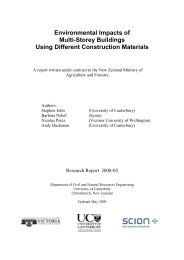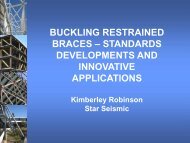SHEAR PERFORMANCE OF STEEL FIBRE ... - SCNZ Magazine
SHEAR PERFORMANCE OF STEEL FIBRE ... - SCNZ Magazine
SHEAR PERFORMANCE OF STEEL FIBRE ... - SCNZ Magazine
You also want an ePaper? Increase the reach of your titles
YUMPU automatically turns print PDFs into web optimized ePapers that Google loves.
Shear stress (MPa)plain concrete equals to'0.65c'find the correlation to be 0. 8'f , Mansur et al. (2008) proposed 0. 6150.56fc, Boulekbache et al. (2012)0.72fc. Mirsayah and Banthia (2002) did shear tests on concrete samples withcompressive strength of 47 MPa and obtained the shear strength of the plain concrete to be 7.5 MPa. Theycommented that this value is expected to depend indirectly on the compressive strength of concrete.The second term in Equation (1) expresses the additional shear resistance due to the presence of steelfibres.Figure 7 shows a comparison of the test results and the predictions of the proposed model for ultimate shearstrength of SFRC.121080.75√f c ' + 4V f0.96420C35 series - ExperimentalC60 series - Experimental0 0.2 0.4 0.6 0.8 1Fibre volume fraction (%)Figure 7. Comparison of test data of the present study and the proposed model for ultimate shear stress ofSFRC.ConclusionThe FIP shear test method was successfully used to obtain the shear performance of the SFRC and plainconcrete. The results demonstrate that the addition of steel fibres of as much as 20 kg/m 3 changes thefailure mode from brittle failure to a ductile failure. This means that the material can sustain significant loadsafter cracking. The improvements in shear strength of SFRC were more significant for steel fibre dosagesabove 40 kg/m 3 (0.5% fibre volume fraction), in both normal and high strength concrete. An empirical modelwas derived, based on regression analysis, to predict the shear strength of SFRC specimens.AcknowledgmentWe wish to acknowledge the Heavy Engineering Research Association for initiating this research projecttogether with the Heavy Engineering Education and Research Foundation for providing part of the financialsupport for the tests. Also, we wish to acknowledge MBIE Natural Hazards Research Platform, CompositeSolutions Grant. We also are grateful to Alan Ross from BOSFA (Bekaert OneSteel Fibres Australasia) forproviding the steel fibre. This paper is from the ASEC2012 Conference (Perth, Western Australia).ReferencesASTM. 1998. Standard test method for compressive strength of cylindrical concrete specimens. StandardASTM C39/CC39M-05, American Society for Testing and Materials (ASTM), West Conshohocken, Pa.Beushausen, H., & Alexander, M. 2008. Bond strength development between concretes of different ages.<strong>Magazine</strong> of Concrete Research, Vol 60(1) 65-74.Boulekbache, B., Hamrat, M., Chemrouk, M., & Amziane, S. 2012. Influence of yield stress and compressivestrength on direct shear behaviour of steel fibre-reinforced concrete. Construction and Building Materials. Vol27(1) 6-14.
















